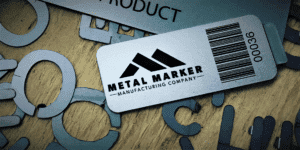A company logo says a lot about the organization it represents. Just seeing a famous logo can provide feelings of happiness or negativity, depending on a customer’s experience with that brand.
For most industrial companies, a logo is a means to offer a seal of approval and quality. You know what to expect when you use a tool that is adorned with a particular logo.
Why would an organization spend the time and money to build a brand reputation and not capitalize on it? By adding your company logo to your equipment, your organization can make the most out of this valuable asset.
Applications
Asset Marking
A key element for industrial companies is loss prevention. Industrial equipment and tools can be very expensive and a target for theft.
By incorporating a branded nameplate into a tool, the item becomes significantly less valuable. For example, adding “Property of Company X” to a machine means it can’t simply be resold.
In addition, logo labels help prevent mix-ups of equipment. For example, a construction site with many contractors sharing a project is prone to mix-ups in gear and tools. A company label on the equipment is a simple but highly effective way to prevent someone from accidentally taking the wrong gear.
Branding
If you produce a tool that is used out in the field, seeing your product used can be important.
Simply put, if someone likes what you produce, you want them to know who made it. Many manufacturers utilize identification plates such as this to provide contact information or a website address.

A common user of logo nameplates, furniture manufacturers often use their logo on their furniture. This helps identify the maker if there are issues, or if a customer wants to buy more.
As mentioned, if your brand reputation is that you produce a quality, long-lasting product, including your logo on the items you produce can help reaffirm these beliefs during usage.
Marking Processes
Photo Anodizing
Photo anodization is one of the most versatile marking processes due to its level of customization. These metal nameplates can be marked with any design, including a logo.
The upside is that the design is embedded beneath aluminum layers, offering substantial durability even in the harshest industrial environments.
Anodized nameplates can even include a solid background color, furthering the organizational branding.
Stamping
For marking many tags with the same logo, stamping can be an effective option. In order to stamp a custom logo, a custom stamp must first be produced.
This can be an expensive proposition if you only need a handful of tags marked. However, large scale production runs are able to amortize the cost across many tags.
Stamped logos must also be relatively simple, as the impression will be hard to distinguish with a complex design.
Printing
For color logos, there isn’t a better process than printed decals and labels. Ink is printed onto a vinyl or polyester material, offering a bold and stand-out appearance.
Printing offers the ability for multiple colors to be used in a custom logo.
These labels do suffer from less durability than a metal based tag, although they are perfect for many applications.
Industries
With such a wide scope of applications, organizations in many industries can find use for marking their logo.
Some prominent industry examples include:
- Construction
- Warehousing
- Manufacturing
- Transportation
- Oil & Gas
- Shipyards
- Aerospace
- And Many More
Wrap-Up
It may not be the top of your organization’s to-do list, but adding an identification label or tag with your company logo to an asset can derive many benefits.
From negating theft to promotional branding, there are countless reasons why using your logo alongside your equipment is advantageous.